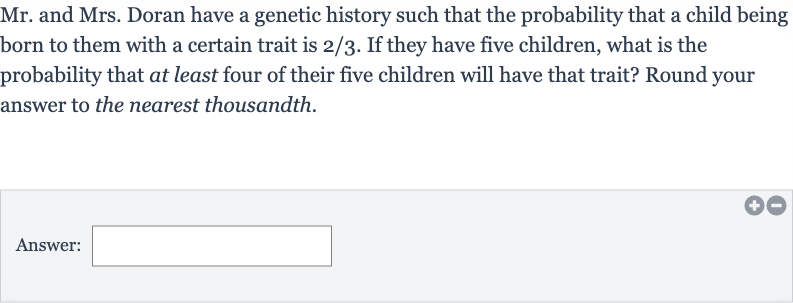AI tutor
Welcome to Bytelearn!
Let’s check out your problem:

Mr. and Mrs. Doran have a genetic history such that the probability that a child being born to them with a certain trait is . If they have five children, what is the probability that at least four of their five children will have that trait? Round your answer to the nearest thousandth.Answer:
Full solution
Q. Mr. and Mrs. Doran have a genetic history such that the probability that a child being born to them with a certain trait is . If they have five children, what is the probability that at least four of their five children will have that trait? Round your answer to the nearest thousandth.Answer:
- Identify values for formula: Identify the values of , , and for the binomial probability formula. (the number of children) (the probability of a child having the trait)We want to find the probability of at least four children having the trait, so we need to calculate the probability for and .
- Use binomial probability formula: Use the binomial probability formula for .Substitute , , and into the formula.
- Calculate binomial coefficient: Calculate the binomial coefficient .
- Calculate : Calculate .
- Calculate : Calculate .
- Calculate : Calculate .
- Use binomial probability formula: Use the binomial probability formula for .
Substitute , , and into the formula. - Calculate binomial coefficient: Calculate the binomial coefficient .
- Calculate : Calculate .
- Calculate : Calculate .
- Calculate : Calculate .
- Calculate probability of at least four children: Calculate the probability of at least four children having the trait.This is the sum of the probabilities for and .
- Convert probability to decimal: Convert the probability to a decimal and round to the nearest thousandth.
More problems from Find probabilities using the binomial distribution
QuestionGet tutor help
QuestionGet tutor help
QuestionGet tutor help
QuestionGet tutor help
QuestionGet tutor help
QuestionGet tutor help
QuestionGet tutor help
QuestionGet tutor help
QuestionGet tutor help
QuestionGet tutor help
